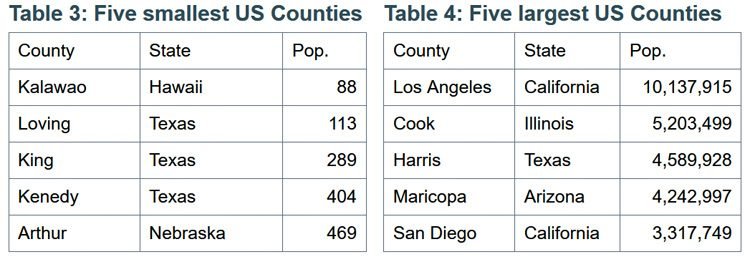More Than Half Of U.S. Population Lives In 4.6 Percent Of Counties
![]() At the county level, the geographic distribution of the estimated 325.2 million people in the United States clearly distinguishes two main areas where people live: “big” counties and “small” counties…
At the county level, the geographic distribution of the estimated 325.2 million people in the United States clearly distinguishes two main areas where people live: “big” counties and “small” counties…
State population numbers reveal how many people live in each state, but one of the keys to understanding the complexities of the U.S. population distribution is to look at where people live.
At the county level, the geographic distribution of the estimated 325.2 million people in the United States clearly distinguishes two main areas where people live: “big” counties and “small” counties.
More than half of all residents live in just 143 big counties (in terms of the number of residents), according to an analysis of U.S. Census Bureau county estimates. That means less than half of the population is spread out across the remaining 2,999 small counties.
![]()
![]()
The five smallest counties in the nation and the five largest are listed in Tables 3 and 4, respectively.
![]()

![]()
“Fourteen states don’t have any of the big counties,” said Larry Sink, Census demographer, who analyzed the data released June 22. They include: Alaska, Arkansas, Idaho, Iowa, Louisiana, Maine, Mississippi, Montana, New Hampshire, South Dakota, North Dakota, Vermont, West Virginia and Wyoming.
By contrast, there are 17 states where a majority of the population resides in big counties, as shown in Figure 1. In California, for example, more than 85 percent of residents (33.5 million) live in big counties. Ten million people live in Los Angeles, the nation’s most populous county.
“We see a predominance of these big counties on the east and west coasts,” Sink said. “Small counties are more commonly found in inland areas.” This is similar to demographic patterns commonly seen around the world. The map in Figure 2 shows how these counties are distributed across the country.
![]()
“The most populous counties are often transportation hubs and major ports,” Sink said. “The small counties are mostly found in landlocked areas in the Great Plains, mountains and deserts. It’s not uncommon for these counties to even be losing population over time.”
The differences between the two geographies also extend to age. The median age in small-county America is 39.1 compared with 36.9 for big-county America, and 54 percent of people age 65 or older live in small-county America.
There is also a notable difference in the rate of growth. “Big-county America is growing nearly twice as fast as small-county America,” Sink said. “They’re not only getting bigger but increasingly more diverse.” Thus, if current trends continue, it’s likely that the divide between big and small will continue to become more pronounced in the future.






